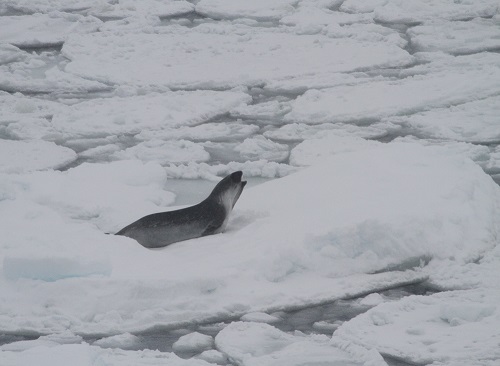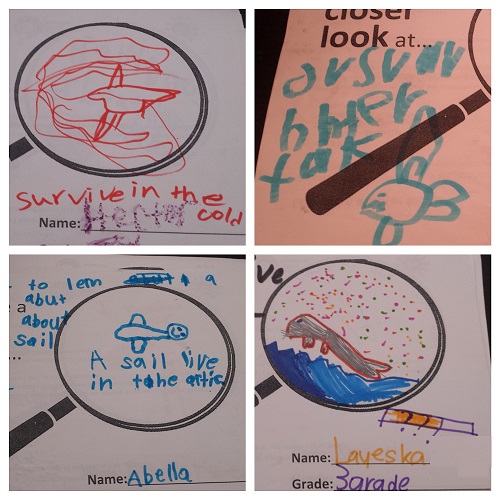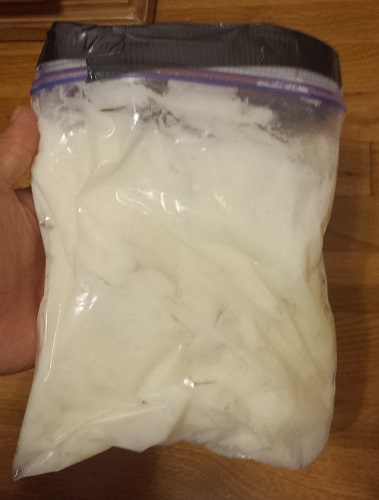It’s really warm today. The ice has melted off the ship and I went
outside without a jacket or thermals, just jeans and a hoodie. It’s 35F…
it’s above freezing! So unusual for this time of year and the area.

We’re back to taking lots of CTDs and have 3-4 planned for today. We also happen to be in thicker sea ice, so occasionally we peer out the portholes we can spot wildlife, like seals!
We’ve spotted Weddell seals so far and today we got lucky and saw some
Ross seals, a species much harder to find out here. This Ross seal is
posturing, with his head up and mouth open, warning us (the entire ship)
to back off.

Let’s Take a Closer Look at Seals

Abella, 2nd grade, and Layeska, 3rd grade, want to take a closer look at seals. Hector, 3rd grade and Zakk, 1st grade want to know how seals survive in the cold.
There are lots of seals in the Antarctic. In fact the most numerous
large mammal on earth, the crab eater seal, makes its home in
Antarctica. In the area of East Antarctica we’re in, we can see Weddell
seals, Crabeater seals, Ross seals, Southern elephant seals, and leopard
seals.

Seals are pinnipeds, which means “fin” or “feather” footed, and refers
to the big flippers of seals and sea lions. “True” seals are different
from sea lions and fur seals. Sea lions and fur seals (not true seals)
have big front flippers and smaller rear flippers and can bend at the
waist to walk on “all fours.” They also have ear flaps. True seals have
smaller front flippers and larger rear flippers and no ear flaps (only
ear holes). They cannot bend at the waist and instead, move by
scrunching their way along the ground when out of water.

Both true seals and sea lions are very agile in the water, swimming around to catch food like fish, crabs, or in the case of leopard seals—penguins and even other seals. Both seals and sea lions have a thick layer of blubber, a special kind of fat, which they used to stay warm in the water. The seals in Antarctica can get very large, with the biggest, Southern elephant seals reaching over 8000 lbs!
Try it out on your own
You can try out how blubber keeps seals warm for yourself by making a “blubber” glove. We’ll use vegetable fat instead of real seal blubber though.
You will need: 2 quart size Ziploc bags, 3 sticks of Crisco, duct tape, ice, water, large bowl and a timer.
To make your blubber glove:
* Fill one Ziploc bag with the Crisco, be careful not to get the Crisco
on the zipper part of the bag.
* Turn the other Ziploc bag inside out and carefully insert it into the
bag full of Crisco. Align the zippers on each bag and seal.
* Reinforce the seam with duct tape to ensure no Crisco will leak out.
* Gently squish the Crisco around the bag until it is evenly
distributed.

Test your blubber glove: * Get a large bowl and fill it with ice water. * Put your hand in the ice water without the glove, no blubber insulation, and time yourself to see how long you can survive comfortably. Don’t leave your hand in too long or you could hurt yourself. * Place your other hand in the blubber glove and then put the gloved hand into the ice water. Don’t let the ice water inside your blubber. Time yourself to see how long you can survive comfortably.
How did the blubber impact how long you stayed in the cold water? Do you think different marine mammals have different amounts of blubber?


Comments